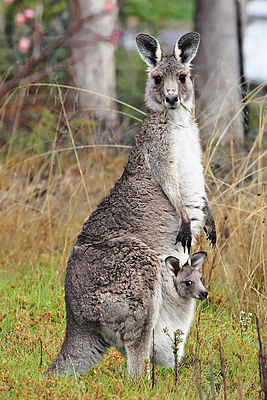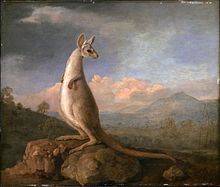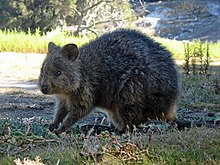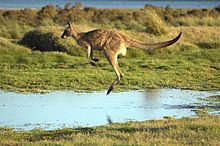Kangaroos
| Kangaroos | ||||||||||||
|---|---|---|---|---|---|---|---|---|---|---|---|---|

Eastern gray giant kangaroo ( Macropus giganteus ) |
||||||||||||
| Systematics | ||||||||||||
|
||||||||||||
| Scientific name | ||||||||||||
| Macropodidae | ||||||||||||
| Gray , 1821 |
The kangaroos (Macropodidae; from the Greek μακρός makrós "big" and πούς poús , Gen. ποδός podós "foot") - in contrast to the rat kangaroos also called real or actual kangaroos - are a family from the marsupial order Diprotodontia . They are among the most famous marsupials and are typical representatives of the Australian fauna , but they also live in New Guinea . Kangaroos are characterized by their significantly longer hind legs. They are herbivores and predominantly crepuscular or nocturnal. The family includes around 65 recent species, four of which are extinct.
features
General physique

Kangaroos differ significantly in their dimensions. While the largest species, the red giant kangaroo , can reach a height of 1.8 meters and a weight of 90 kilograms, the shaggy rabbit kangaroo weighs only 0.8 to 1.8 kilograms and has a head body length of 31 to 39 centimeters . In almost all species, the hind legs are significantly longer and stronger than the front legs; Exceptions are the tree kangaroos , which have adapted to life in the trees and are no longer hopping around, and whose rear and front legs are approximately the same length. The tail is long, muscular and mostly hairy, it is often used as a support or balance, but cannot be used as a prehensile tail. The nail kangaroos have a bony tip. The fur is mostly colored in gray or brown tones, there are also patterned species, for example the rock kangaroos .
The front paws are small and end in five fingers; they are used for food intake and for support. The rear foot is narrow and elongated, kangaroos are sole walkers (plantigrad). The first toe of the hind feet is missing, the second and third toes have grown together as in all Diprotodontia, but end in two separate nails that are used for grooming. The fourth toe is the longest and strongest, the fifth is medium in size.
Head and teeth
The head is elongated, but relatively small compared to the body size. The ears are big. In the upper jaw, kangaroos have a total of six incisors , in the lower jaw only two. As with all Diprotodontia, the lower incisors are enlarged and hit a hard point on the palate behind the upper ones when biting. The upper incisors are arranged in a U or V shape and do not lie one behind the other as in other Diprotodontia. This arrangement is an effective tool for plucking even hard plant materials and is also found in a convergent form in some cloven-hoofed animals . The lower canine teeth are missing, the upper ones are also missing or are severely receded, so that a large gap ( diastema ) separates the incisors and the molars . The premolars are narrow and blade-shaped, the molars are wide and high-crowned. The molars do not come out of the gums at the same time, but one after the other; only when the front ones are worn out and fail do the next ones come and then move forward in the mouth. Overall, the kangaroo's tooth formula is I 3/1, C 0-1 / 0, P 2/2, M 4/4 - so they have a total of 32 or 34 teeth.
Internal anatomy and reproductive tract
The stomach of the kangaroo has developed like that of the ruminant with multiple chambers. It has three sections: the first section, the forestomach sac, serves as a fermentation chamber , where, similar to the rumen, plant food is processed with the help of microorganisms . Further digestion takes place in the tubular forestomach tube and in the posterior stomach. The intestine is long, as in most herbivores, the appendix well developed. The cardiovascular system shows no special features compared to other marsupials. The reproductive tract also largely corresponds to that of the other marsupials. The penis of the male lies drawn in and s-shaped bent in a penis pocket, the testicles lie in front of the penis. Females have two uteri and two vagines and, in contrast to many other marsupial mammals, a permanent pouch (Marsupium). Its opening protrudes forward and it contains four teats. Male kangaroos do not have a pouch.
distribution and habitat

Kangaroos are found in Australia including offshore islands such as Tasmania and New Guinea . They inhabit different habitats and can be found in tropical rainforests as well as in bush or grasslands and dry steppe and desert regions. Some species such as the rock and bush kangaroos also inhabit mountainous regions and can be found at altitudes of over 3,100 meters.
Way of life
Activity times and social behavior
The kangaroos are also variable in terms of activity times and social behavior. Most species are crepuscular or nocturnal, but to varying degrees they can also be observed during the day, for example when sunbathing in the afternoon. They spend the day in the shade of trees, in caves or crevices and in other shelters. These animals do not develop any pronounced social structures; sometimes loose associations of several individuals are formed, but these are not permanent.
Locomotion
Depending on how fast they need to be, many species of kangaroo have two types of locomotion: At higher speeds they only jump with their hind legs, the tail stays in the air and serves for balance. In this way they can briefly reach a speed of 50 km / h. In the larger species these jumps are often 9 meters wide, in a gray giant kangaroo 13.5 meters were measured. These jumps are hardly higher than 1.5 meters.
When walking slowly, kangaroos use "five limbs": while the animal is supported with front paws and tail, the hind legs swing forward; as soon as they stand, the front paws and tail are brought up again. Hopping is very efficient at high speed. Thanks to special, highly elastic muscle ligaments, they can move forward quickly without spending a lot of energy, which is an advantage in a dry climate and sometimes poor food supply. At low speed, however, this sequence of movements is rather inefficient and energy-consuming. Kangaroos cannot move backwards and cannot move their hind legs individually.
The tree kangaroos do not hop, but they can climb well. The short-tailed quokkas and filanders move mainly on all fours.
food
Kangaroos are herbivores that feed on a wide variety of plants depending on their habitat. In simple terms, a distinction can be made between grass-eating (for example red and gray giant kangaroos) and more leaf-eating representatives (for example tree kangaroos), which also differ significantly in the shape of their molars. To varying degrees, they also consume other parts of the plant such as fruits, buds and other things. Thanks to their efficient digestive tract, they can make good use of the difficult-to-digest plant food, and some species also chew again. These adaptations - combined with the ability to get by with little water - mean that they can survive even in dry areas with little vegetation.
Reproduction
As with all marsupials , kangaroo babies are born relatively underdeveloped after a short gestation period of around 20 to 40 days compared to placenta animals . Even with the largest kangaroo species, the red giant kangaroo, the young animal measures only 2.5 centimeters at birth and weighs 0.75 grams. Usually only a single young is born, twins are rare. After giving birth, it crawls independently from the birth canal into the pouch and hangs itself with its mouth on a teat that it will not let go of for the next two to three months.
In many species there is a “delayed birth”: Immediately after the birth of a young animal, the female mates again. However, this embryo hardly continues to grow until the large young animal has finally left the pouch. Only then does the embryo develop and come into the world. The evolutionary advantage is likely to be found in the sometimes inhospitable habitats of these animals: if the young animal dies or the mother has to leave it, a successor is there immediately.
After about six months, the young animal leaves the bag for the first time; at around eight months it has finally become too big to fit in. However, young animals are suckled until they are around one year old. To do this, they put their heads in their mother's pouch, where often another young animal is already being fed. In such cases, large and small young animals drink from different teats, which also give off milk in different compositions.
In Australia, the young of most species of marsupials are called "joeys".
Kangaroos and people
Discovery and name

One of the earliest written evidence of the perception of the kangaroo by Europeans is the diary entries of the British navigator James Cook from July 1770, which also contain a description. The name kangaroo (English: kangaroo ) comes from the language of the Aboriginal tribe of the Guugu Yimidhirr , who live on the Cape York Peninsula . It is derived from the word "gangurru" (or gang-oo-roo ), which is used as a name for a gray giant kangaroo. The tribe has several words for the different species of kangaroo. According to a widespread story, Cook would have been the first European to sight these animals, and the name kangaroo means "I don't understand" in this Aboriginal language and is said to have been answered by the British to their question, "What kind of animal is that?" It was not until the 1970s that the linguist John B. Haviland discovered during his research with the Guugu Yimidhirr that this story was incorrect.
In 1771 Cook also brought two kangaroo bellows to England, which, after being stuffed, served the famous animal painter George Stubbs as a model for a widely reproduced oil painting.
According to old German spelling, the correct spelling was kangaroo . This was changed in the course of the 1996 spelling reform , since then Kangaroo has been correct.
use
Kangaroos were already important prey animals for the Aborigines - they hunted them for their meat ( kangaroo meat ) and also processed the kangaroo skin . On the other hand, the slash and burn carried out by the Aborigines, be it for hunting or, more recently, for simple agriculture, created new living space. The juxtaposition of burned-down areas, areas with young green and densely overgrown areas offered the animals food and refuge.
The Europeans also hunted these animals after their arrival. Today most of the Australian kangaroo species are protected. The red and gray giant kangaroos, however, which have spread significantly since the arrival of the Europeans and have no natural predators, are hunted. In contrast to many other commercially used animals, there are no breeding farms. The shooting is subject to strict quotas; Every year around three million animals are shot in Australia.
Kangaroo meat has had a bad rap for a long time. It was considered poor people's food only for those who could not afford any other meat. In Australia, the meat is not very popular and is processed into animal feed. A large part is exported - 80% to Europe. Also leather is produced from hunted kangaroos. Kangaroo leather is considered to be very tear-resistant due to the even alignment of the collagen fibers and is used, among other things, to manufacture gloves (e.g. the palms of motorcycle gloves), shoes and boots.
threat

A greater threat to the kangaroos than hunting - which only affects the larger species - was and is the destruction of their habitat. The Aboriginal concept of slash and burn was abandoned in favor of extensive pasture and agriculture, which severely restricted the habitat of many species. The reenactment by imported robbers such as the red fox plays a further role .
Depending on their habitat and behavior, the species reacted differently to the changed living conditions. Four species (two species of rabbit kangaroo , the moon nail kangaroo and the eastern Irmawallaby ) are extinct. Other species only inhabit a fraction of their previous habitat - the banded rabbit kangaroo only lives on two small islands off the coast of Western Australia . There are also less endangered species: The rock kangaroos live mainly in mountainous regions that are unusable as animal pastures - therefore they do not have to fear any threat from this direction. The giant kangaroos are also widespread and not endangered.
The species in New Guinea were not exposed to the colonization of their habitat by the Europeans, but today they too suffer from the deforestation of the forests and the associated loss of their habitat. Several species of tree and bush kangaroos on this island are considered threatened according to the IUCN .
The greatest threat to the kangaroos remains humans. Australian farmers see the animals as a threat to their livelihoods, as they eat up their fields, and fight them in a variety of ways. Potions are poisoned and many kangaroos are shot. Despite the clear legal situation in Australia to kill the animals immediately after an injury, they are often brought to the slaughterhouses alive. Every year the Australian government releases a certain number of kangaroos that can be killed. However, animal rights activists point out that there are too few controls, especially the government is accused of protecting the kangaroo processing industry.
Another common cause of kangaroo deaths in Australia is cars or the widely used road trains . Deliberately running over the animals is prohibited, but it does happen quite often.
Cultural references
In the myths of the Aboriginal dreamtime there is a " big kangaroo ". It made the animal people hold back the water when the great flood came. Then it spits out all the words that people on earth speak. It thus became the creator of all tones, sounds and languages.
A kangaroo and an emu are the heraldic animals of Australia . Both animals can only move forward, which represents progress. In addition, kangaroos are ubiquitous as symbolic animals in Australia, for example on the emblem of the Qantas Airways airline or on the Australian one-dollar coin .
Systematics
External system and history of development

Within the marsupial mammals, kangaroos belong to the order Diprotodontia and within this group to the subordination of the Macropodiformes or Macropodoidea. In addition to the actual kangaroos, this subordination also includes the rat kangaroos (Potoroidae) and the primitive musk rat kangaroo , which is part of its own family Hypsiprymnodontidae . The kangaroos probably evolved from tree-dwelling animals that resembled the musk rat kangaroo. This animal has a number of peculiarities that are no longer found in other species: it is very small, has almost equally long fore and hind limbs and a bare tail. The sister group of the kangaroos are the rat kangaroos. The parentage relationships within the Macropodiformes are expressed in the following cladogram:
| Macropodiformes ("kangaroo-like") |
|
||||||||||||
|
|
Within the kangaroos, the subfamily of the short- snouted kangaroos (Sthenurinae) first appeared in the Miocene , but reached their greatest diversity in the Pleistocene . It was generally characterized by a more solid build than today's species. In this subfamily, the genus Procoptodon developed the largest kangaroos. The banded rabbit kangaroo used to be the only representative of the Sthenurinae still alive today . In the meantime, however, it is placed in the subfamily of the Lagostophinae. The Sthenurinae have therefore been extinct since the late Pleistocene. The remaining recent species all belong to the Macropodinae subfamily, which has also been documented since the Miocene.
In the Pleistocene , around 51,000 to 38,000 years ago, there was a mass extinction of larger animals in Australia, which affected several giant kangaroos ( Procoptodon , Simosthenurus ) as well as other groups of marsupials such as the diprotodons and the marsupial lions . This extinction has worldwide parallels, the time of this Quaternary extinction wave roughly correlates with the history of human settlement. It is unclear to what extent human hunting ( overkill hypothesis ) or climatic factors are responsible - due to the binding of large water masses during the Würm Ice Age , there was severe drought. A mixture of the two causes is also conceivable: the animal world, which has been affected by the climatic changes, could no longer have withstood the hunting pressure that began with the arrival of humans.
Internal systematics - the recent genera


Within the kangaroos there are eleven genera with a total of 65 recent species; 4 of these species are already considered extinct:
- The banded rabbit kangaroo ( Lagostrophus fasciatus ) is the most primitive living representative of the kangaroos and is classified in its own subfamily, Lagostrophinae.
- The bush kangaroos (6 species in the two genera Dorcopsis and Dorcopsulus ) are rainforest inhabitants of New Guinea.
- The tree kangaroos (genus Dendrolagus ) are tree-dwelling animals in New Guinea and on the Australian Cape York Peninsula. There are 12 types.
- The rock kangaroos ( petrogals ) are medium-sized, often patterned animals that live in mountainous countries in Australia. The genus includes 16 species.
- The filanders are characterized by a hardly hairy tail. The 7 species of this genus live in Australia and New Guinea.
- The rabbit kangaroos ( Lagorchestes ) got their name because they are reminiscent of hares in terms of size and locomotion. Of the four species, two are already extinct.
- The quokka or short-tailed kangaroo ( Setonix brachyurus ) is characterized by its short ears and short tail.
- The nail kangaroos ( Onychogalea ) have a bony nail at the tail end. The genus includes two living and one extinct species.
- The swamp wallaby ( Wallabia bicolor ) is a small species from Southeast Australia.
- The genus Macropus comprises 14 species, which can be divided into three subgenera:
- The subgenus of the wallabies ( Notamacropus ) counts 8 species, including one extinct.
- The sub-genus of the gray giant kangaroo ( Macropus ) is composed of two species.
- The subgenus Osphranter consists of the three species of the mountain kangaroo and the red giant kangaroo , the largest living kangaroo species.
The genealogical relationships of the genera to one another are shown in the following diagram. This was developed by Marcel Cadillo and others in 2004 using a combination of many different phylogenetic studies.
| Kangaroos (Macropodidae) |
|
||||||||||||||||||||||||||||||||||||||||||||||||||||||||||||
|
|
literature
- Terence J. Dawson: Kangaroos . Cornell University Press, Comstock, Cornell 1995, ISBN 0-8014-8262-3 .
- Tim Flannery: Mammals of New Guinea . Cornell University Press, Cornell 1995, ISBN 0-8014-3149-2 .
- Udo Gansloßer (Ed.): The kangaroos . Filander, Fürth 1999, 2004, ISBN 3-930831-30-9 .
- Bernhard Grzimek : Grzimeks animal life. Volume 10, Mammals 1 . Droemer-Knauer, Munich / dtv, Munich / Bechtermünz, Augsburg 1979, 2000, ISBN 3-8289-1603-1 , pp. 128-164.
- John A. Long, including: Prehistoric Mammals of Australia and New Guinea . Johns Hopkins University Press, Baltimore 2003, ISBN 0-8018-7223-5 .
- Ronald Strahan: Mammals of Australia . Smithsonian Books, Washington DC 1996, ISBN 1-56098-673-5 .
- Ronald M. Nowak: Walker's Mammals of the World . 6th edition. Johns Hopkins University Press, Baltimore 1999, ISBN 0-8018-5789-9 .
Web links
Individual evidence
- ↑ Figures from Walker (1999), pp. 115 and 119.
- ^ Ulrich Zeller: Marsupialia (Metatheria, Didelphia), marsupials. In: Wilfried Westheide and Reinhard Rieger (eds.): Special Zoology Part 2: Vertebrate or Skull Animals, Gustav Fischer Verlag, Stuttgart Jena & New York 2003, ISBN 3-8274-0900-4 , pp. 491–492.
- ↑ Nowak (1999), p. 120.
- ^ Animal Diversity Web: Macropus rufus
- ↑ John Hawkesworth: Detailed and credible history of the latest journeys around the world, which were undertaken on the orders and costs of the now ruling King of England in the years 1764 to 1772 ... , translated by JFSchiller, Berlin: Haude and Spener, 1775, vol 4 (quoted here from Guy Deutscher : Im Spiegel der Sprache , Munich: Beck 2010, p. 181 f.)
- ↑ Tony Horwitz : Cook - The discovery of a discoverer. Piper, Munich 2006, pp. 271f. ISBN 3-492-24473-4
- ^ Douglas Harper, Historian: kangaroo . In: Online Etymology Dictionary . Dictionary.com. December 22, 2009. Retrieved September 25, 2013.
- ^ John B. Haviland: A last look at Cook's Guugu-Yimidhirr wordlist. In Oceania. 44 (3), 1974, pp. 216-232 PDF - see pp. 216 (note 1) and 229
- ↑ kangaroo . In: The American Heritage® Dictionary of the English Language, Fourth Edition . Houghton Mifflin Company. 2004. Retrieved December 22, 2009.
- ↑ Duden: Kangaroo
- ↑ An industry that's under the gun: Report from the Sydney Morning Herald of September 26, 2007
- ↑ The whole point ... ( Memento of April 2, 2009 in the Internet Archive ), accessed on May 10, 2009.
- ^ Kangaroo meat boom on BBC News March 16, 2001
- ↑ Information from KIAA (Kangaroo Industry Association of Australia) ( Memento of October 13, 2009 in the Internet Archive )
- ↑ [1]
- ↑ Kangaroo road kills can often be avoided! ( Memento from December 27, 2012 in the Internet Archive )
- ^ R. Lewis: The Beginner's Guide to Australian Aboriginal Art. The symbols, their meanings and some Dreamtime stories. 3rd edition 2004, Fountainhead Press, Canning Vale DC, ISBN 0-646-40368-0 .
- ↑ a b M. Cardillo, ORP Bininda-Emond, E. Boakes, A. Purvis: A species-level phylogenetic Supertree of marsupials. in: Journal of Zoology. London 264.2004 (PDF). ISSN 0268-196X
- ↑ Prideaux, GJ and Warburton, NM (2010), 'An osteology-based appraisal of the phylogeny and evolution of kangaroos and wallabies (Macropodidae: Marsupialia)', Zoological Journal of the Linnean Society , 159 (4), 954-87. doi : 10.1111 / j.1096-3642.2009.00607.x
- ↑ TS Kemp: The Origin & Evolution of Mammals. Oxford University Press, Oxford 2005, ISBN 0-19-850761-5 , pp. 288-290.
- ↑ after Don E. Wilson, DeeAnn M. Reeder (Ed.): Mammal Species of the World . A Taxonomic and Geographic Reference. 3. Edition. Johns Hopkins University Press, Baltimore 2005, ISBN 0-8018-8221-4 .





